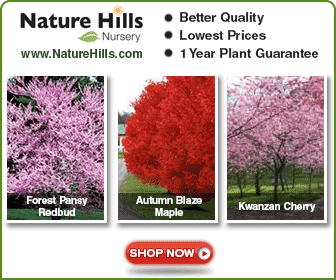Arizona Vegetable & Fruit Gardening
For The Arizona Desert Environment
Pictures, Photos, Images
Descriptions, & Reviews.
George & Eve Delange
Arizona Raised Bed
Vegetable & Fruit Tree Gardens.

|
 |
| Raised Bed Garden Made Out Of Old Railroad Ties. Looking North. Red Circled Area #1 On Google Map. Arizona Raised Bed Vegetable Gardens For The Arizona Desert Environment. |
|---|
 |
| Raised Bed Garden Made Out Of Old Railroad Ties. Looking South. Red Circled Area #1 On Google Map. Note: Eve deLange Placed Flagstone Between The Raised Beds. Arizona Raised Bed Vegetable Gardens For The Arizona Desert Environment. |
 |
| Locations Of Our Raised Bed Gardens. Arizona Raised Bed Vegetable Gardens For The Arizona Desert Environment. Circled Numbered Areas Correspond To Images On This Page. Image Courtesy Of: Google Earth. Image May 15, 2011. |
Most Of These Items Are For Someone Who Just Wants To Start
Or For Someone With Just A Small Area To Plant Their Garden
Click On The Item For A More Detailed Look. No Obligation!
Eve & George deLange faced a dilemma at their get away home in Yarnell, Arizona. How To Garden? Should they do it the traditional way, and be faced with a lot of digging in hard clay soil? And then be faced with adding compost and nutrients to the soil, and all of the other disadvantages with old soil. Or try a new way of doing it, called Raised Bed Gardening? After doing some research which included looking at the Yarnell Community Garden Project in Yarnell, Arizona; to see how it is locally done. We decided, Raised Bed Gardening is the way to go! In the long run, it's easier to do and cheaper! Raised bed Gardening has become very popular over the past few years since raised beds are relatively inexpensive. easy to build, plant, weed, and to maintain. Another great idea is to grow vegetables and other plants in your raised bed garden that are compatable with each other. If we put those two ideas together, we get what Eve & George deLange like to call, "Compatible Raised Bed Gardening" in Arizona. Please, be sure to take a look at our page called: Arizona Compatible Vegetables That Grow Well Together. We have started practicing what we preach and we have had fewer pests in the garden and the plants seem to love each other!! By the way, we are two very young thinking people, both of us, in our 70's! We have both been moving rocks and stone, bags of mulch and topsoil, fertilizers, spading soil, etc.. If we can do it, almost anyone can! And best of all, we are having a great time doing it! Got to eat one of our first tomatoes this year. Boy, did it ever taste great! Considering the cost of the garden, and the work we have put into it; that tomato was the most expensive tomato we have ever eaten. But, it was the best! Oh, another side note; its about creosote-treated railroad ties. We know that a lot of folks say, "don't use them". George and his family have used them for years. No Problems! They act as a natural barrier to keep Bunny Rabbits out of your vegetables.They don't like the creosote smell..... We know some people whose entire garden, and flower beds, are all made from railroad ties. They say they are great and they last forever! If you don't want to use them, there are plenty of other products that you can use instead. Precast wall stones. Cement Blocks. Bricks. Premade Raised Bed Garden Kits. Natural Rock & Stone. Cedar and Redwood Boards. 4" x 4" or 4" x 6" sizes are available. Other naturally rot-resistant wood, or wood treated with a safe preservative.
Or, Click Below to see how to turn a Galvanized Livestock Water Trough into a Compost Bin or Raised Bed Garden.
Galvanized Livestock Water Troughs to make into Compost Bins or Raised Bed Gardens.
Whatever method you use, the next step is critical, prepare a good soil mix for your raised bed using good topsoil, organic matter, lime if needed and the appropriate amount and type of fertilizer . Prepare a good soil mix for your raised bed using good topsoil, organic matter, lime if needed and the appropriate amount and type of fertilizer. Note: If your topsoil has a lot of clay in it, add sand to your soil mixture. Here is a good rule of thumb guide to use. We spade up the existing soil as deeply as we can. Then for every ten square feet of bed we pour on a two cubic foot bag of soil conditioner . On top of this we add two bags of Pavestone Paver Leveling Sand (available at home improvement stores). We also scatter a pint of garden lime and about a half-bag of hen manure on the ten square foot site. Our Mantis tillers make short work of mixing it all together but, if the soil is dry, a shovel works just as well. We finish the job by raking the bed smooth, before watering it and placing seeds or plants into the soil. A great resource about soil preparation for Arizona is the Arizona Soil Types And Fertilizers To Use. Mix all the various elements together before placing the mix in the raised bed. Lightly compact the mix to take out excessive air space. Note: Most mixes will settle during the first year, so anticipate adding more mix for the second season.
Tools you may need are:
When making raised beds, there are two types you may wish to consider first. Should they be Permanent or Temporary beds?
Permanent Beds:
If building your bed on soil, improve its drainage by loosening the soil in the bottom of the bed first, with either a shovel or spading fork. Then fill the bed to the top with a well mixed mixture of compost and topsoil. Be sure to test the fill and add any amendments that it might need. Be careful that you do not use too much nitrogen, it can burn new plants.
Temporary Beds:
Shovel garden soil into your raised beds, or use in a mixture of compost and topsoil. Your beds can be of any shape you desire: curved, rectangular, or even round. The basic idea is to build your beds about 12 to 18 inches inches deep and no more than 3 to 4 feet wide. Remove all sticks, rocks, and other debris, and rake the tops of your beds so they are smooth and flat. Now The Fun Part! Planting your raised beds. Plant your favorite vegetables, herbs, and flowering plants at the proper times for your area. Concentrate watering and any fertilizer right around the plants, and try not to compact the soil by stepping on it. Plant any tall growing plants against either a wall, or to the north side of the bed. Water your plants regularly. Raised beds could dry out faster than other types of garden beds, so water them regularly. Also, since there is less soil mass to provide food for the plants, you must fertilize them regularly with an all-purpose plant fertilizer. We suggest making regular tests of your soil. Mulch. You can mulch your plants with straw, shredded bark, or other organic materials to conserve water and to prevent weeds from growing in the beds. We use shredded bark, and other organic materials
Tips:
If a plant gets diseased or infested with insects, pull it out immediately and replace it with a different plant so the problem doesn't spread. Grow your climbing plants such as pole beans and cucumbers on trellising at the back of the bed. Place your cascading plants such as petunias in the front of the bed so they can spread off of the bed.
A great resource about Raised Bed Gardening in Arizona is written by the Arizona Cooperative Extension, College of Agriculture, The University of Arizona. It is called, the Vegetable Garden: Intensive Gardening Methods. Another great resource about Raised Bed Gardening in Arizona is written by the University of Arizona Cooperative Extension, Yavapai County; Jeff Schalau, Associate Agent, Agriculture & Natural Resources. It is called, the Raised Bed Construction. During your first year of gardening you will learn that you need somplace to put the waste from your garden. You could just throw it away. But you could use it over and put it back into your garden. After all, it's good for your soil! Here is a great resource on building Compost Materials that can be reused back into your garden. This resource is written by the University of Missouri Extension, The University of Missouri. It is called, the How to Build a Compost Bin. It tells you everything you need to know!
Here are some others:
Building a Raised Bed Garden
Garden Use of Treated Lumber
NOTE: If you look carefully at the first few photos below; you will see the growth of our raised bed garden over a few months from the beginning of its construction until the end of the growing season of 2011.
|
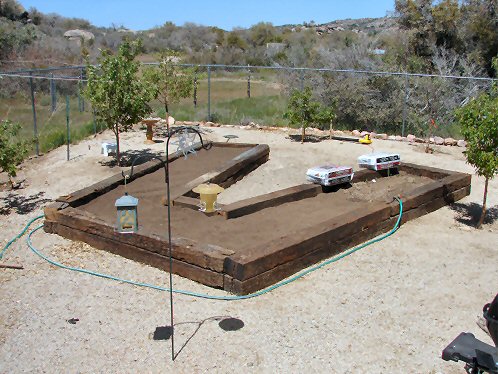 | 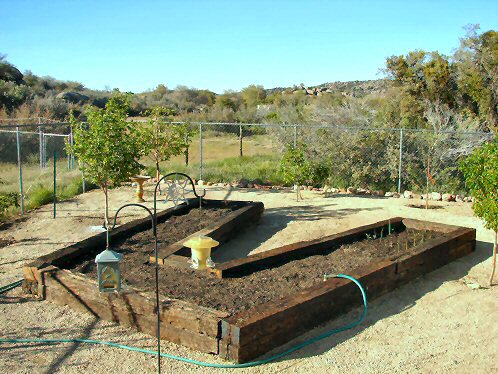 |
| Raised Bed Garden Made Out Of Old Railroad Ties. We Had Just Finished Construction. April 29, 2011. We Are Filling With Proper Soil Mixture. Asparagus Crowns Had Just Been Planted. Red Circled Area #1 On Google Map. | Raised Bed Garden Made Out Of Old Railroad Ties. Asparagus Spears Are 6 To 9 Inches High. May 01, 2011. We Are Waiting To Plant Seeds & Potted Plants. Red Circled Area #1 On Google Map. |
|---|---|
 |  |
| Raised Bed Garden Made Out Of Old Railroad Ties. We Were Watering On A Timer. June 09, 2011. We Are Filling With More Topsoil. Red Circled Area #1 On Google Map. | Raised Bed Garden Made Out Of Old Railroad Ties. We Were Watering On A Timer. June 25, 2011. Everything Seems To Be OK. Red Circled Area #1 On Google Map. |
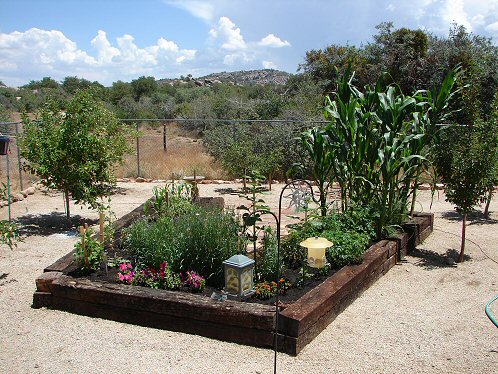 |  |
| Raised Bed Garden Made Out Of Old Railroad Ties. We Were Watering On A Timer. July 09, 2011. We Are Filling With More Topsoil. Red Circled Area #1 On Google Map. | Raised Bed Garden Made Out Of Old Railroad Ties. Had To Add More Topsoil To Corn. July 14, 2011. Corn Is 8 Foot 6 Inches Tall. Monsoon Wind Almost Blew Over Corn July 10, 2011. Corn Had Been Staked & Tied. But Needed More Topsoil. Over 45 MPH Wind ENE. 2.50 Inches Rain In 3 Days. Red Circled Area #1 On Google Map. |
 |  |
| Raised Bed Garden Made Out Of Old Railroad Ties. Corn Is 12 Foot 1 Inches Tall. July 29, 2011. Sprayed Sevin For Infestation Of Wingless Potato Aphid , Macrosiphum euphorbiae. Red Circled Area #1 On Google Map. | Raised Bed Garden Made Out Of Old Railroad Ties. Corn Is 12 Foot 1 Inches Tall. July 29, 2011. Sprayed Sevin For Infestation Of Wingless Potato Aphid , Macrosiphum euphorbiae. Red Circled Area #1 On Google Map. |
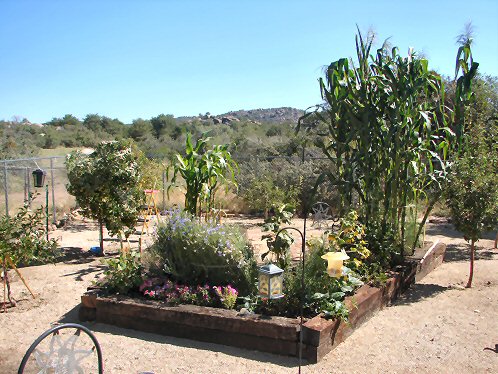 | 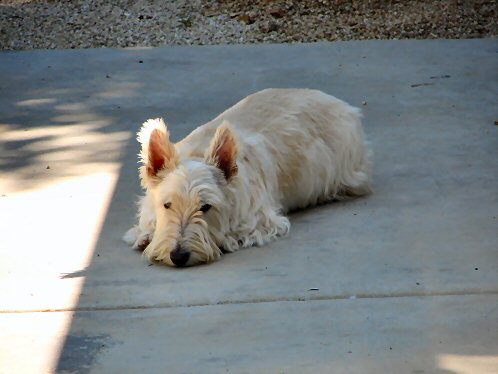 |
| Raised Bed Garden Made Out Of Old Railroad Ties. Corn Is 14 Foot 3/4 Inches Tall. August 5, 2011. Female Corn Silks Starting To Show Red Circled Area #1 On Google Map. | Our Alert, Faithful, Guard Dog, Amber, Carefully Watching For Pests To Chase Away From Our Raised Bed Garden Made Out Of Old Railroad Ties. Red Circled Area #1 On Google Map. |
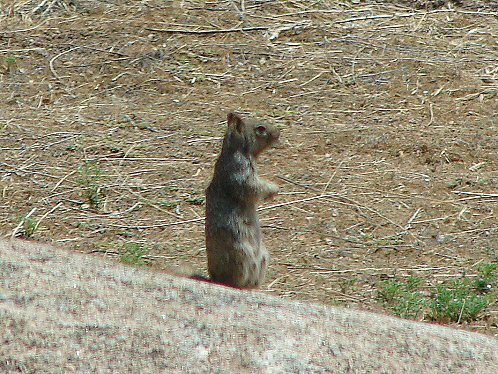 | 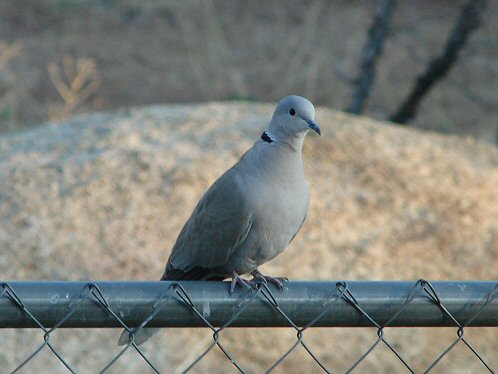 |
| Rock squirrel, Spermophilus variegatus Watching Our Raised Bed Garden Made Out Of Old Railroad Ties. He Loves To Eat Our Cornflowers, Centaurea cyanus July 13, 2011. But That Keeps Him Out Of The Other Vegies. Red Circled Area #1 On Google Map. | Ring-necked Dove (Streptopelia capicola) Watching Our Raised Bed Garden. They Love To Eat Harmful Insects. Raised Bed Garden Made Out Of Old Railroad Ties. Red Circled Area #1 On Google Map. |
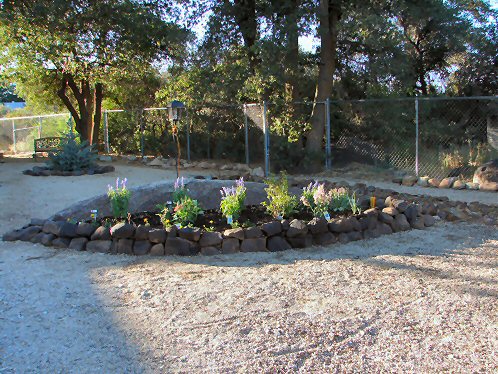 | 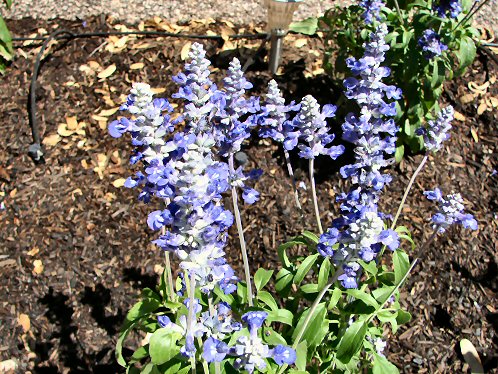 |
| Raised Flower Bed Surrounded By Natural Rock. Red Circled Area #2 On Google Map. | Raised Flower Bed Surrounded By Natural Rock. Blue Salvia, Salvia farinacea. Red Circled Area #2 On Google Map. |
 | 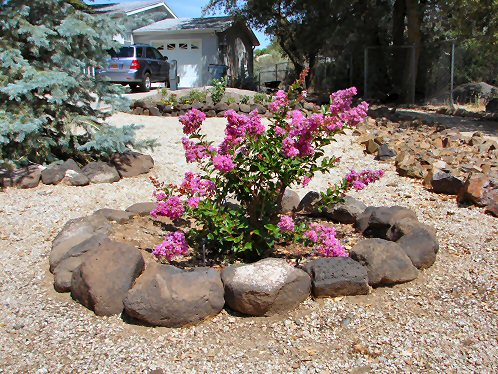 |
| Flower Bed Surrounded By Natural Rock. Red Circled Area #3 On Google Map. | Flower Bed Surrounded By Natural Rock. Notice It Matches & Blends With Other Beds. Red Circled Area #3 On Google Map. |
 | 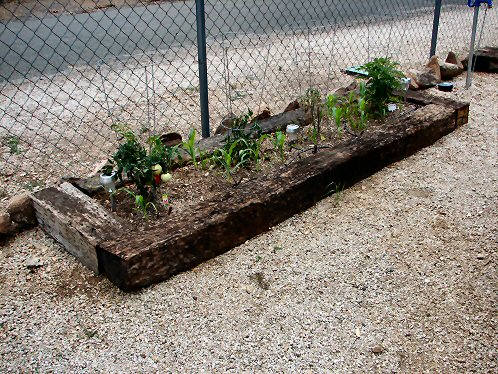 |
| Raised Flower Bed Garden Made Out Of Old Railroad Ties. Red Circled Area #4 On Google Map. | Raised Flower Bed Garden Made Out Of Old Railroad Ties. Red Circled Area #5 On Google Map. |
 | 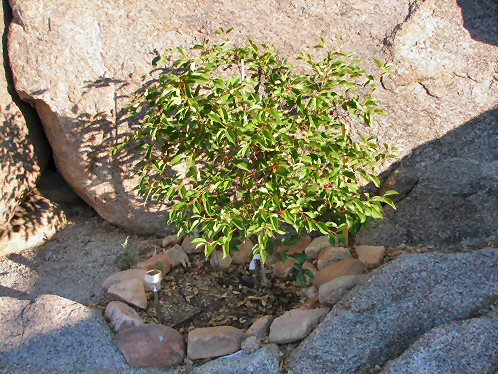 |
| Raised Flower Bed Garden Made Out Of Old Railroad Ties. Red Circled Area #6 On Google Map. | Raised Cherry Tree Bed Made Out Of Natural Rock. Red Circled Area #7 On Google Map. |
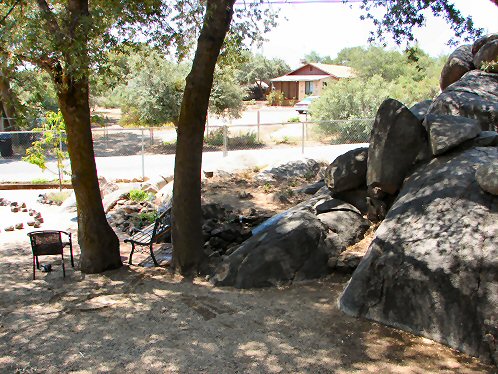 | 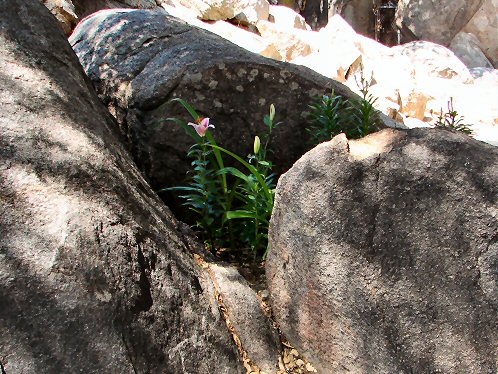 |
| Raised Bed Garden Made Out Of Natural Rock. Entire Red Circled Area #8 On Google Map. | Raised Bed Garden Made Out Of Natural Rock. Partial Red Circled Area #8 On Google Map. |
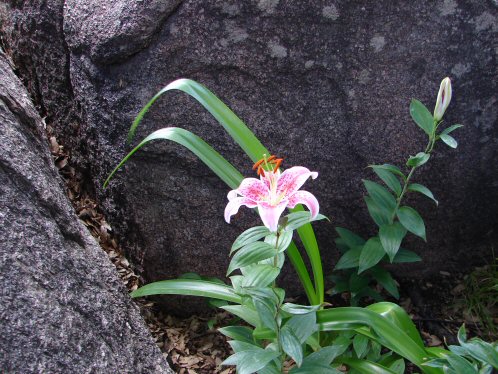 | 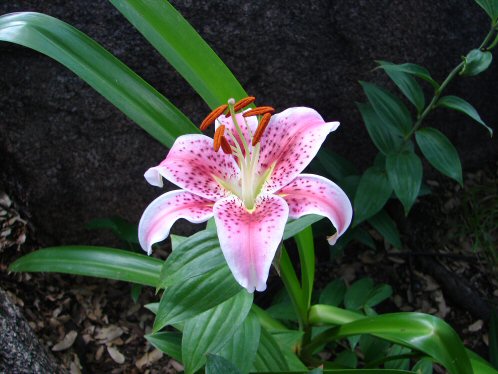 |
| Flowers In Raised Bed Garden Made Out Of Natural Rock. Partial Red Circled Area #8 On Google Map. | Flowers In Raised Bed Garden Made Out Of Natural Rock. Partial Red Circled Area #8 On Google Map. |
 |  |
| Raised Bed Garden Made Out Of Natural Rock. Partial Red Circled Area #8 On Google Map. | Raised Bed Garden Made Out Of Natural Rock. Partial Red Circled Area #8 On Google Map. |
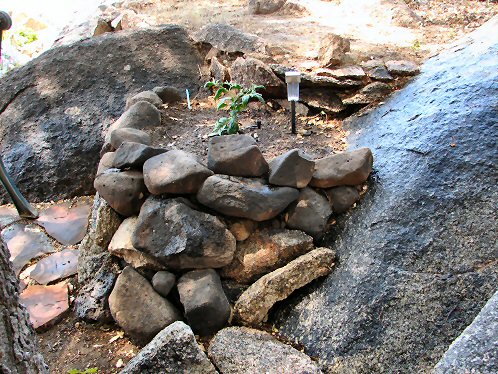 | 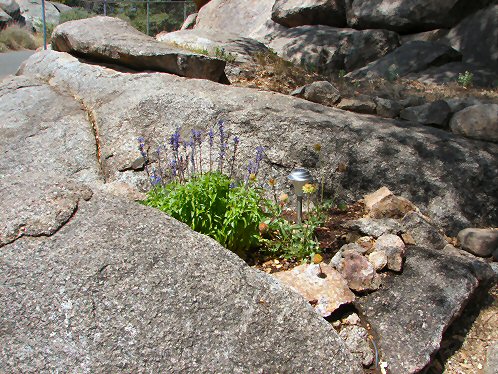 |
| Another Raised Bed Garden Made Out Of Natural Rock. Partial Red Circled Area #8 On Google Map. | Another Raised Bed Garden Made Out Of Natural Rock. Partial Red Circled Area #8 On Google Map. |
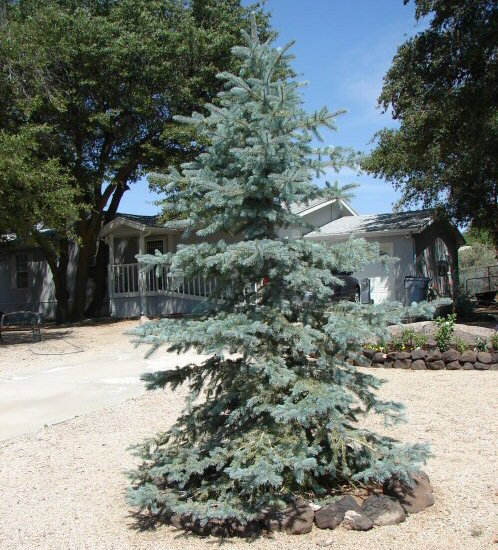 |  |
| Tree Bed Surrounded By Natural Rock. Colorado Blue Spruce, (Picea pungens). | Tree Bed Surrounded By Natural Rock. Fat Albert Colorado Blue Spruce. (Picea pungens glauca 'Fat Albert'). |
 | 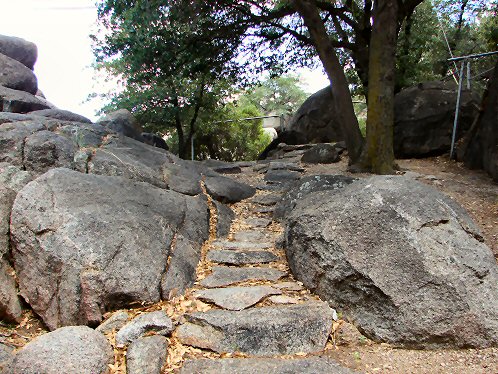 |
| Tree Bed Surrounded By Natural Rock. Fat Albert Colorado Blue Spruce. (Picea pungens glauca 'Fat Albert'). | Natural Rock Area In Need Of Work. |
We Buy Our Hard To Find Fruit Trees For Yarnell Arizona At Nature Hills Nursery.
We Have Several Nice Fruit Trees Growing In Yarnell, Arizona.
They Will Do Well In Other Similar Elevations In Arizona. ie.. Prescott, Cottonwood, Camp Verde, Sedona.
Cameo & Fuji Apples! Yummm! Click The Nature Hills Nursery Link To View.
 /
/

 |
| "Compatible Raised Bed Gardening" In Arizona! With Potatoes, Eggplant, Tomatoes, Asparagus, & Corn Growing Together. Look Carefully & You Will See Some Marigolds Growing! They Chase Off A Few Bugs! We Also Have Three Citrosa Geranium, (Pelargonium, citrosum) Nearby Don't Have Very Many Mosquitoes Or No-see-ums. Compatible Raised Bed Arizona Vegetable & Fruit Gardening, Yarnell, Arizona. |
|---|


| © 1966 - Present, George & Eve DeLange |
We're Glad You Stopped By! Come back soon!
All Of Our Images Are Copyrighted. They May Not Be Used Without Permission.
The Low Resolution Photos That Can Be Downloaded From Our Pages Are Available, Free Of Charge, Upon Request:
To Students, & Teachers For Classroom Use
Any Other Use Is Considered Commercial.
Almost All Of Our Photos (NOT ALL) Are Available In High Resolution, For Commercial Use (Books, Magazines, TV Productions, etc.)
They Are Royalty Free, And A One Time, $30 US Fee Is Charged For Each Photo
Most Of These Items Are For Someone Who Just Wants To Start
Or For Someone With Just A Small Area To Plant Their Garden
Click On The Item For A More Detailed Look. No Obligation!
We Are Proud Of Our SafeSurf Rating!

